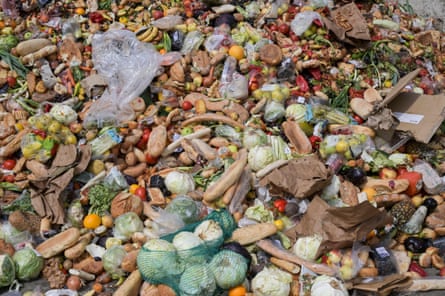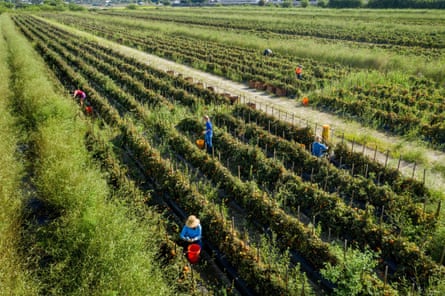As the Mar Vista Farmers Market in Los Angeles came to an end, a small team of volunteers in bright orange aprons handed out large cardboard boxes to be filled with unsold heirloom tomatoes, apricots, berries, green peppers, lettuce and eggplants that would have otherwise gone to waste. After being weighed and cataloged, the boxes were stacked into neat piles and picked up by three local organizations that serve people in need.
The event was hosted by the North Hollywood, California-based Food Forward. Founded in 2009, the non-profit aims to fight hunger and prevent food waste by rescuing surplus produce from backyards, public orchards, farmers markets and the Los Angeles Wholesale Produce Market. The group gleans and donates an average of 250,000lb of food each day to more than 340 hunger relief partners throughout 12 California counties, six adjacent states and tribal lands, feeding 150,000 people their five daily servings of fruits and vegetables in the process.
Food Forward and other groups say the demand for donated produce has increased in recent years.
“During the pandemic, a lot of our [hunger relief agency] partners had to close down, but for the ones that stayed open, they’re seeing four or more times the people they’re serving,” said Ally Gialketsis, Food Forward’s interim associate director of community programs. “Generally we see increases in numbers when there is economic inflation, but there’s always people experiencing food insecurity.”

While 34 million Americans face hunger, up to 40% of everything raised or grown in the US is wasted.
A 2021 report estimated that 2.5bn tonnes of food goes uneaten globally every year, contributing approximately 10% of all greenhouse gas emissions – equivalent to nearly twice the annual emissions produced by all the cars driven in the US and Europe.
In 2019, surplus food cost the country $408bn.
According to the Environmental Protection Agency (EPA), food waste is the single most common material landfilled and incinerated in the US. As that waste decomposes, it produces methane, which traps more than 80 times as much heat on our plant in the short term as carbon dioxide.
“When we waste food, we don’t only waste the physical food, but any labor, time, land and water and energy that went into collecting, harvesting, producing, transporting and storing, so that’s where the impacts really can build up,” said Nina Sevilla, program advocate for food waste and food systems at the Natural Resources Defense Council (NRDC).
Gleaning, the act of harvesting unused or surplus produce and distributing it to food insecure people, is one solution to the interconnected challenges of hunger and food waste. A form of social welfare for thousands of years, gleaning was the norm until farm technology and private property laws began to limit the practice.
But as awareness of food waste has grown in recent years, so has the popularity of gleaning. The Association of Gleaning Organizations estimates there are more than 200 groups nationwide who are helping to deliver fresh quality produce to people in need.

Enough food is produced to feed everyone on the planet. While there’s no silver bullet to solving hunger, reducing food waste is one solution to the United Nations’ goal of achieving Zero Hunger by 2030.
Food surplus became a serious problem after the second world war. While Americans were once asked to sacrifice for the war effort, postwar life meant more abundant, processed and cheaper food. As more people concentrated themselves in urban environments, food waste became the norm since there was no infrastructure to process waste. Changing cultural attitudes meant the practice of throwing away food was no longer taboo, but condoned by society.
While advocates say the most ideal approach to reducing food waste is to not create it to begin with – by improving product development, storage, ordering, marketing, labeling and cooking methods – gleaning and food donation can help hungry people, while inedible food can be recycled into products such as animal feed, compost and worm casings, bioenergy, bioplastics and even clothing.
In 2019, food waste occurred most in residences, followed by farms, foodservice, manufacturing and retail.
“The business models of food production and consumption are intentionally designed for waste production,” said André Nogueira, a researcher and instructor for the health policy and management department at Harvard’s TH Chan School of Public Health.
“If you’re a producer, the more you produce, the more money you make. On the consumer side, everybody likes to have that perception of being fed well – especially if you’re an American.”
Food loss on farms is primarily driven by weather, labor and market conditions. Pricing, grading standards and consumer preferences influence how much a producer will harvest or leave in the field.

In some states, tax credits are available to farmers in exchange for their surplus produce, however they may be insufficient to create a strong incentive for donation as farmers incur costs for materials, resources and labor.
About 30% of food from American grocery stores is thrown away, generating about 16bn pounds of food waste each year. At Kroger, which has the goal to achieve more than 95% diversion, food worth 4% of the 2,800-store chain’s nearly $140bn in annual sales is wasted each year – the equivalent of about $5.6bn.
Grocers, food distributors and consumers prefer to buy shiny red apples, unblemished tomatoes and uniformly straight carrots. But in order to showcase perfect-looking produce, countless pieces are rejected and never even harvested from the field.
In the nearby Coachella Valley, Hidden Harvest is rescuing over a million pounds of produce annually left behind in the fields and orchards after harvest. Founder Christy Porter started the non-profit in 2000 after talking to farm workers whose work was feeding millions of people while they and their families went hungry.
Hidden Harvest pays low-income farm workers a fair wage to rescue produce that they give away to nearly 50,000 needy people each month through their own programs and more than 60 partner agencies that serve poor families.
“I find that everyone I talk to is appalled at the waste of food,” said Porter, a former photojournalist. “People are aware and appalled, but it takes will to make change.”
In December, Senator Richard Blumenthal, a Democrat from Connecticut, introduced a bill that addresses food waste by establishing requirements to standardize the quality date and discard date labels on food packaging, which could help move the needle on food waste since real or perceived food spoilage is one of the main reasons people throw out consumable food.


“Most of the dates printed are the manufacturers best guess as to when the food will be at its peak quality such as color or crunch and not when the food goes bad,” said NRDC’s Sevilla.
Experts say shorter supply chains and a more regional food system would help people appreciate food more and that the government could mandate procurement of compost.
Cities like Los Angeles are scrambling to meet a state-mandated deadline to move food waste out of landfills by the end of the year, which will require the infrastructure to handle up to 3,000 tons of organic waste a day to make compost or alternative technologies like anaerobic digestion.
San Francisco began offering green bin disposal of kitchen scraps more than a decade ago and more than 200 cities in the US already have curbside food scrap pickup.
In addition to California, legislators in Connecticut, Massachusetts, New York, Rhode Island and Vermont have passed laws restricting the amount of food waste going to landfills. Vermont’s 2020 Universal Recycling Law banned food scrap waste altogether, leading to a surge in food donations.
While individuals can certainly make a difference by reducing their own food waste at home and composting and states and cities can show leadership, advocates say there needs to be major changes on the federal level and business innovation side to truly make a difference.
“We need to go beyond little fixes and think more broadly and systematically,” said Nogueira, who noted that the US government itself creates a staggering amount of food waste.
Harvard Food Law and Policy Clinic, NRDC, ReFED and WWF have released a report providing additional recommendations for food waste policy in the 2023 Farm Bill, a roughly $500bn omnibus bill that addresses the American food system.
In the meantime, gleaning groups like Allison Levin’s Community Harvest of Central Vermont are doing all they can to help.
Founded in 2014 with a focus on gleaning fresh produce from local farms as well as bread, meat, dairy and cheese from proprietors, they partner with 36 organizations who distribute the food to places such as senior meal programs, after school programs and shelters.
“Last year we had 427 volunteers that donated almost 3,000 hours and 8,000 miles of their time and vehicles,” said Levin, who grew up on an organic vegetable farm and first heard about gleaning in the Bible. “It’s one of the volunteers’ favorite jobs to be Santa Claus and deliver all that food to our partner sites.”
